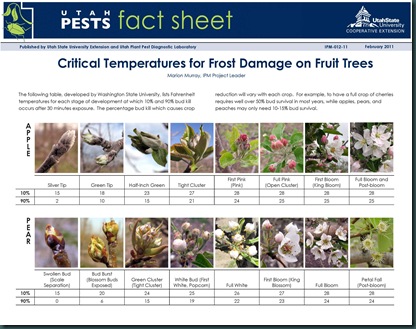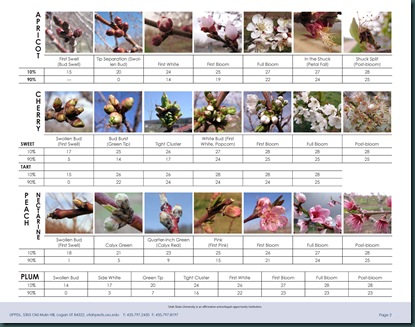 |
| Pheromone lure with trapped moths. |
We have now established a biofix for CM for this spring and it was May 26. You may apply insecticides that need to be present before egg laying at about 50-75 DD or you may apply insecticides that target early egg laying period at 100-200 DD. Since the biofix date, we have accumulated approximately 9 DD, but with the projected hot temperatures for the comming week, we will have to keep a close eye on the degree days for the first application of an ovicide. It will soon be time time for the home grower to apply a spray to target early egg laying.
For the home orchardist who does not have the benefit of a weather station or other means to calculate degree days, a simple tree growth stage time table can be followed. Codling moths usually start flying at bloom time or just after bloom time at petal fall and approximately at the same time as plum curculio. Eggs laid by these moths begin to hatch about two weeks after petal fall, depending on the weather. You can apply the first codling moth spray at this time, about two weeks after petal fall, to prevent larvae from entering the fruit. Because most insecticide residues last 7 to 10 days and moths are continuously present throughout the summer, apply a spray every 7 to 10 days to prevent later broods of codling moth larvae from entering apple and pear fruits. If using a natural product like Spinosad, then spray after every rain due to washoff. Always follow the label directions of any spray you may use.
For the home orchardist who does not have the benefit of a weather station or other means to calculate degree days, a simple tree growth stage time table can be followed. Codling moths usually start flying at bloom time or just after bloom time at petal fall and approximately at the same time as plum curculio. Eggs laid by these moths begin to hatch about two weeks after petal fall, depending on the weather. You can apply the first codling moth spray at this time, about two weeks after petal fall, to prevent larvae from entering the fruit. Because most insecticide residues last 7 to 10 days and moths are continuously present throughout the summer, apply a spray every 7 to 10 days to prevent later broods of codling moth larvae from entering apple and pear fruits. If using a natural product like Spinosad, then spray after every rain due to washoff. Always follow the label directions of any spray you may use.
Several insecticides can be used for codling moth control including acetmaprid and/or spinosad. Acetamiprid is a soft, conventional control and is available as Ortho Flower, Fruit and Vegetable Insect Killer. This is a ready to use product that contains .006% acetamiprid, and is also available in a concentrate containing .5% acetamiprid. Acetamiprid is a synthetic organic compound of the family of chemicals that acts as neonicotinoid insecticides. Acetamiprid is a contact, translaminar insecticide for sucking-type insects and can be applied as a foliar spray. Translaminar insecticides are absorbed by leaves and can move through the leaf to the opposite surface they contact. They are not truly systemic and do not move throughout the entire plant. Acetamiprid acts on a broad spectrum of insects, including aphids, thrips, plum curculio, apple maggot and Lepidoptera, especially codling moth. When sprayed in the evening at sunset, it will not harm bees or other beneficial insects once it is dry. Be sure to follow all label directions on the bottle for proper application.
 An all natural approach is also available in the form of Bonide’s Captain Jack’s Dead Bug Brew. Captain Jack's Deadbug Brew® contains Spinosad (spin-OH-sid), a product first isolated from a naturally occurring soil dwelling bacterium that was collected on a Caribbean island from an abandoned rum distillery. Deadbug Brew® kills bagworms, borers, beetles, caterpillars, codling moth, gypsy moth, loopers, leaf miners, spider mites, tent caterpillars, thrips and more! Use on fruits, vegetables, berries, citrus, grapes, nuts and ornamentals and approved for organic gardening.
An all natural approach is also available in the form of Bonide’s Captain Jack’s Dead Bug Brew. Captain Jack's Deadbug Brew® contains Spinosad (spin-OH-sid), a product first isolated from a naturally occurring soil dwelling bacterium that was collected on a Caribbean island from an abandoned rum distillery. Deadbug Brew® kills bagworms, borers, beetles, caterpillars, codling moth, gypsy moth, loopers, leaf miners, spider mites, tent caterpillars, thrips and more! Use on fruits, vegetables, berries, citrus, grapes, nuts and ornamentals and approved for organic gardening. Both of the above products will kill Codling Moth larvae and need to be sprayed just prior to the emergence of the larvae, which is between 100 to 250 DD after biofix. Since we are not yet at or near 100 DD after biofix, your trees can be sprayed in about 7 to 10 days, depending on the amount of rain that may fall at night between now and then. Typically after 1" of rain, these sprays will have been washed off and will need to be sprayed again to be effective.
For additional information, see the following fact sheets which are available from local university extension services:
http://extension.psu.edu/plants/tree-fruit/insects-mites/factsheets/codling-moth
Reference in this publication to any specific commercial product, process, or service, or the use
of any trade, firm, or corporation name is for general informational purposes only and does not
constitute an endorsement or certification of any kind by Royal Oak Farm.
People using spray products assume responsibility for their use
in accordance with current label directions of the manufacturer.











